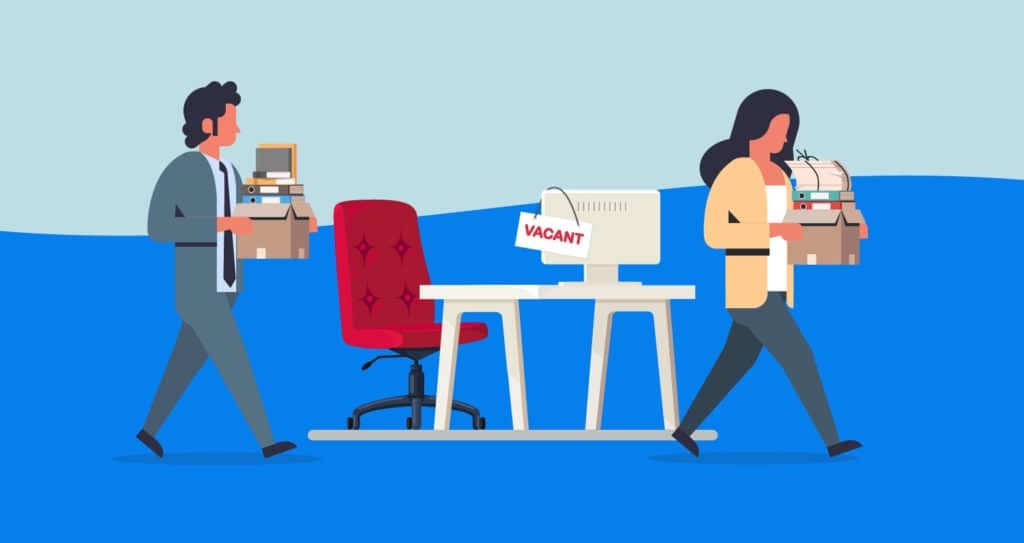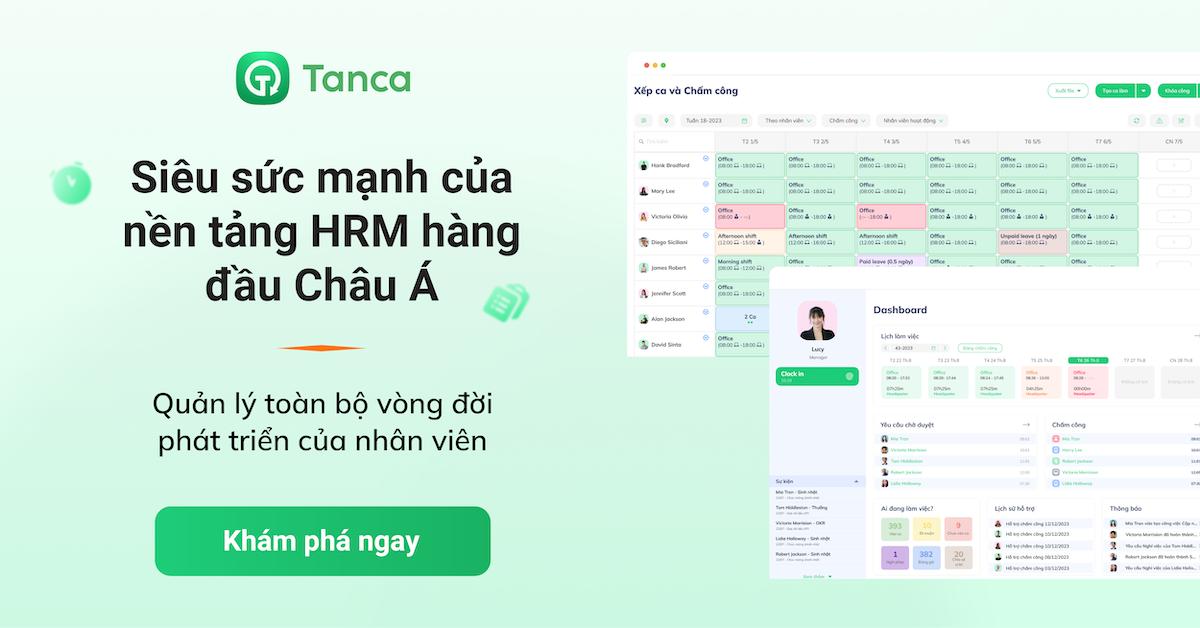Employee Turnover Vs Attrition: Employee attrition is the term used to describe the loss of a worker due to a natural occurrence. Voluntary leaves are included in employee turnover. To help you know more about this, Tanca will describe each in more detail below, along with how they differ and what they mean for the business.
Now, let’s start!
What is employee turnover?

The number of employees that leave a company during a given time period, usually one year, is referred to as employee turnover or employee turnover rate.
Turnover can apply to divisions inside an organization, such as specific departments or demographic groups, even though an organization typically tracks the overall number of people that leave.
Employee attrition can occur for a variety of reasons. These include dissatisfaction with employee perks or pay structures, a lack of staff growth possibilities, and even a terrible working environment.
Formula: Employee turnover rate is frequently expressed as a percentage by businesses. It is determined by dividing the number of departing employees in a year (or other period) by the typical number of employees working for the company during that time.
Read more: What Is An Advantage Of Hiring Contingent Workers?
Types of employee turnover

Voluntary turnover
Voluntary turnover affects every organization. At some point, people will feel it's time to move on and are likely to depart. However, you can lower your voluntary turnover rate.
You probably already have exit polls set up for employees who leave on their own volition. If not, begin here!
Surveying employees that choose to quit your company will provide crucial information about how to proceed. Use this information to comprehend:
- Why did an employee leave?
- what you might have done to change it.
- The organization's reaction to their departure.
You should keep a close check on your undesired turnover. This is when great achievers leave for avoidable reasons.
Involuntary Change
When a corporation urges an employee to quit, this is referred to as involuntary turnover. This could be because of:
- Inadequate performance.
- Problems with behavior.
- Changing business requirements
- Budget reductions
- Reorganization of structures/force reductions
The common belief is that an employer provides this choice and that the employee never intended to quit. However, there are always two sides to every story when it comes to involuntary turnover.
Utilize your turnover statistics to verify that the company came to a just decision that the employee won't be negatively affected.
Transfers inside the organization
Internal transfers include employees changing jobs within the same company. Employee turnover of this nature can be an indication of a good movement. However, there could be other motivations for an employee's cross-team move.
Exit interviews might provide a clearer insight of an employee's motivation for transferring. It might have been due to their desire for a new position or a chance for advancement. It's also possible that they're fleeing a nasty boss, mistrust of coworkers, or a lack of growth.
You may learn what is working on a general level and where specific teams could improve with the use of this kind of survey data. When one person departs a team or department, managers have a chance to ensure that those who remain are engaged.
Retirement
People often believe that retirement exits are unavoidable and beyond the company's control. According to polls, some employees get disenchanted and prefer to retire early. They may opt to leave your organization but continue their career.
Make an exit survey for retirees. This can assist you grasp their specific requirements and challenges. You'll be able to discover strategies for engaging and retaining older, tenured personnel.
Retiree input can help you improve your workplace and retain new staff for the long term.
Read more: What Is The Difference Between Parttime And Fulltime?
Pros and cons of employee turnover
Pros | Cons |
|
|
What is attrition of employees?

Employee attrition is the progressive decrease in employee numbers. Employee attrition is the deliberate choice not to hire new employees to replace those who leave an organization on their own volition.
If the number of your staff decreases over time, employee attrition will take place. This suggests that personnel are being hired at a higher rate than they are being replaced.
Employees depart for a variety of reasons. It could be to accept a better offer from another organization, to advance farther, or to change their career path. Life events like retirement or moving to a different state can cause it.
Formula: The quantity of full-time employees who leave each month (known as "separations"), divided by the average quantity of employees, is multiplied by 100 to determine your staff attrition rate.
Types of employee attrition
Employee attrition is most simply understood as the loss of a worker as a result of a normal event or procedure. Some examples of this could be:
Unwilling attrition
When a firm decides to split ways with an employee, this is known as involuntary attrition. Instead of the employee choosing to quit, the decision to fire the worker is made by the employer.
This could be because of:
- Position removal.
- Termination.
- Layoffs.
When a corporation eliminates a specific position, this is the most prevalent type of involuntary attrition. This decision to eliminate a post could be motivated by a desire to cut staffing costs and remain financially solvent.
Attrition through choice
An employee who chooses to quit the organization is said to have undergone voluntary attrition. This could be for a variety of reasons.
The following are some of the most frequent reason for voluntary attrition:
Acceptance of a new job offer
- Making a professional transition.
- Relocating from across country to be near loved ones and family
However, the reasons can be more unpleasant, such as when an employee resigns from their employment due to illness. Or even resignation in order to escape a hazardous work environment.
Attrition in retirement
Employees who are nearing retirement age experience retirement attrition.
If only a tiny fraction of your staff leave your organization, the impact will be minimal. However, a large attrition rate may result if a sizable portion of your personnel departs all at once.
Pros and cons of employee attrition
Pros | Cons |
|
|
Employee Turnover Vs Attrition

What is the different turnover and attrition
The primary distinction between them is that when an employee leaves, the business looks for a replacement. However, when attrition occurs, the employer either doesn't fill the position or does away with it entirely.
When an employee departs the company, there is both employee turnover and attrition. In short, turnover can result from a variety of activities such as discharge, resignation, termination, or abandonment. Attrition happens when an employee retires and when a company eliminates a position.
What causes employee turnover and attrition?
- Financial strain: Workers who are under financial strain—for example, those who are unable to save money or who are living paycheck to paycheck—are more likely to be searching for higher-paying positions, which may result in their departure.
- Stagnancy: While some individuals are satisfied with their current position, many others are eager for professional growth possibilities and hence career advancement inside a company. If that's not provided, they might look for opportunities elsewhere.
- Unfriendly working conditions: If the company isn't willing to accommodate or make an effort to encourage work/life balance, possibilities for professional advancement, or ignores employee morale issues, it's possible that turnover will increase.
Reviewing the Negative Effects of Attrition and Turnover
Turnover can either be beneficial or detrimental for an organization depending on the circumstances. It can be anticipated or unexpected, planned or unplanned.
For instance, a sales team may have a high turnover rate as junior team members rise to more senior teams within the same company, or a fast-food restaurant may have a high turnover rate as individuals leave for higher-paying positions.
Both firms will survive as long as those exits are anticipated and there is a strong demand for new staff. It would be obvious there is a problem if the rate of turnover was more or lower than anticipated and budgeted for.
Despite the forces acting on them, these arches have stood steady for hundreds of millions of years. While their shape varies over time, their base remains stable—until nature triumphs and the arches collapse.
In the situation of employee attrition, wherein external factors cause the loss, a choice is made as to whether the leaving reduces the size of your organization.
That decision will determine whether the business's foundation remains sturdy or cracks due to a lack of support. Attrition can be helpful or harmful for an organization depending on the situation, just like turnover, which can be expected or unexpected, planned or unplanned.
However, what if that business wanted to bring on a young colleague but the senior partner decided against retiring?
The business would be left paying two wages and incurring even more costs until it chose to forcibly remedy the issue with a layoff or termination. A sudden change in attrition of that nature can be dangerous.
Read more: How To Conduct HR Investigation?
Attrition and Turnover is a Part of a Successful Business Strategy
Answer the common questions
How many workers are required to serve a single customer? The mission of your organization can't be accomplished by one person alone, but it also doesn't require too many individuals.
Consider the following inquiries that a service-based company might make to ascertain its workforce requirements:
- How many additional support personnel will be required to assist the additional customers that more sales personnel bring in?
- What ought to be the appropriate staffing ratio for marketing?
- How much of the slack left by a departing coworker can each department's employees pick up?
- Will we require more workers at certain points during the year to accommodate increases in workload?
- Do you know how much turnover or attrition to anticipate within the upcoming several months?
- Do your staff members understand what to anticipate from the company?
When is two-way communication appropriate?
While you can't expect to have complete awareness of your employees' personal lives or for them to behave consistently at all times, you can nevertheless learn about the former and encourage the latter by promoting open, two-way communication.
There are three chances to accomplish so, as follows:
Manager/employee private meetings. While managers should be providing their staff with timely, regular feedback, scheduling formal one-on-one meetings allows them more time to connect with staff.
Employees can question their supervisors for clarity on any recent team changes, and managers can inquire about employees' career ambitions and life events during one-on-one meetings.
All-staff updates meetings. Company executives can provide background information and context during all-hands meetings on complex topics including employee attrition, business financial health, and long-term strategy.
This type of top-down, direct communication lessens the possibility that information would be misunderstood or twisted when it is sent through several persons. It also enables employees to base decisions on facts rather than rumors or market trends.
Managerial meetings: Connecting the dots is the only thing left to do if managers are speaking with staff and staff are receiving reliable information from leaders.
Manager-level gatherings that allow team leaders to openly discuss patterns they are noticing and how corporate choices are affecting their workers give HR and talent managers the chance to second-guess their hiring strategy.
It's crucial to choose wisely when and who to hire, and finding the right balance between the two can be challenging. You run the risk of incurring a mishire's monetary and cultural consequences if you hire too early. When you hire slowly, you put workers in understaffed teams in the dreaded " to be efficient" situation and raise the risk of burnout.
Why Context is Important for Turnover and Attrition?
The only thing that will never change about your company is change.
Employees continuously seek cues on how to respond to changes because their jobs play such a significant role in their lives.
Your staff can be reassured that attrition and turnover are not indicators the ship is sinking and it's time to run for the lifeboats by maintaining consistent communication, making consistent decisions, and moving in a path that is consistent with your values.
Your leadership team may take action by making decisions that build your culture, the working environment for employees, and ultimately your retention rate if they have the proper understanding on how to anticipate and arrange for employee attrition and turnover.
Read more: Furloughs vs Layoffs
Frequently Asked Questions
How do you calculate turnover and attrition?
How are turnover and attrition calculated?
Simply divide the total number of positions you have available by the total number of employees who depart each year to determine your attrition rate, (also with your turnover rate).
What is an acceptable attrition rate?
Although it can be challenging to pinpoint what constitutes a "good" attrition rate, firms should usually aim for just an attrition rate of 10% or below. But keep in mind that, depending on the situation, this figure will differ from firm to company and industry to industry.
What is the average turnover rate for 2022?
According to Gartner, Inc, the number of Americans quitting their employment voluntarily each year is expected to increase by about 20% this year, from a pre pandemic annual average of 31.9 million employees to 37.4 million in 2022.
Conclusion
It's vital to keep in mind that both employee attrition and turnover can cost your business money; the exact amount depends on the reasons why the employees left.
Whatever the case, it's in a company's best advantage to make an effort to control the rate of staff attrition and reduce turnover each year.
Implementing employee opinion surveys, conducting exit interviews (and acting on the results), setting up workplace financial wellness initiatives like a budgeting program, or looking for ways to enhance current perks, discounts, and other advantages are a few effective approaches to achieve this.
Tanca hopes this article has given you a better understanding of staff attrition vs. turnover. If you have any queries or would want to share your thoughts, please leave a comment below.










